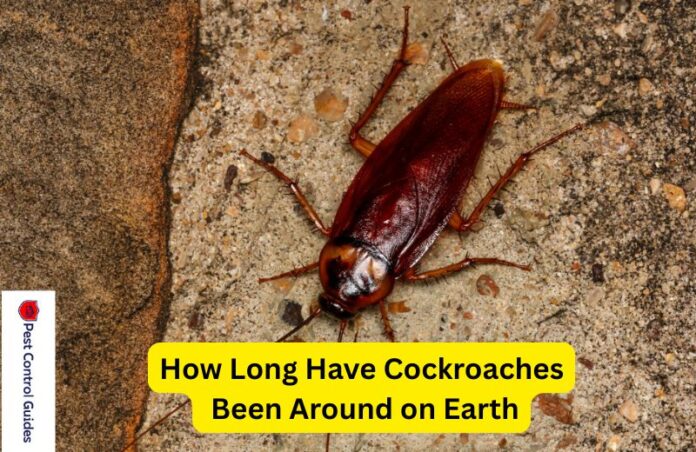Cockroaches have amazed scientists for decades because of their incredible ability to survive. These ancient insects are not just pests; they are living proof of nature’s adaptability. But how long have cockroaches been around? The answer will shock you. Fossil records show that cockroaches have existed for over 300 million years! That makes them older than dinosaurs and one of the longest-surviving species on Earth.
Ancient History of Cockroaches
Origins Over 300 Million Years Ago
Cockroaches have been crawling around since the Carboniferous period, more than 300 million years ago. Fossil evidence reveals early cockroach-like ancestors called “roachoids.” These creatures were some of the first insects in Earth’s history and had features that resemble modern cockroaches.
Roachoids had flat, oval bodies with long antennae, much like today’s cockroaches. Unlike modern roaches, though, some roachoids had larger, more mantis-like appearances, hinting at their evolutionary pathway. Over time, these insects adapted to their changing environments, becoming the cockroaches we know today. Yesterday we published a post on Types of Bugs That Look Like Cockroaches?
Survival Traits of Cockroaches
What makes cockroaches such incredible survivors? Their mix of physical, physiological, and behavioral adaptations ensures they can thrive in almost any environment.
Physical Adaptations
- Flat Bodies: Their slim, flat shape lets them squeeze into tiny cracks and crevices, away from predators.
- Speed: Cockroaches are very fast and use their agility to escape threats.
- Wings: While not all species fly, some use their wings to glide to safety or move quickly.
Physiological Adaptations
- Reproduction: Cockroaches multiply quickly. Some species lay dozens of eggs at a time, allowing colonies to grow rapidly.
- Omnivorous Diet: Roaches will eat nearly anything, from decaying plant matter to glue and soap, making them extremely adaptable in terms of food.
- Surviving Harsh Conditions: These insects are known for surviving extreme heat, cold, and even radiation levels that harm other living things. Read also Types of Cockroaches with Pictures
Behavioral Adaptations
- Nocturnal Lifestyle: Cockroaches are most active at night, avoiding predators and human attention.
- Hiding in Small Spaces: They are experts at finding safe, hidden areas where they can remain undetected.
Read Our Most Recently Published Guides on Termites, Earwigs, Fruit Flies and Gnats:
- Do Bed Bugs Fly or Jump? How to Get Rid of Bed Bugs in a House 2025
- How Fast Does Alcohol Kill Bed Bugs on Mattress Permanently in 2025
- How Big are Termites? How to Identify Termites and Treatment
- What Color are Termites? Their Types of Termites
- Fruit Flies vs Gnats: How to Tell the Difference in 2025
- Fungus Gnats vs Fruit Flies: How to Tell the Difference in 2025
- How to Get Rid of Plant Gnats Fast? Prevention and Treatment Tips
- How to Get Rid of Fungus Gnats in House Fast? Fungus Gnats Treatment Tips
- Are Earwigs Dangerous or Poisonous to Humans and Dogs?
How Cockroaches Have Survived Extinction Events
Cockroaches are often called the ultimate survivors. This reputation is well-deserved. They have lived through mass extinction events, including the asteroid impact that wiped out the dinosaurs 66 million years ago. Their ability to survive is due to their flexibility and adaptability. When other animals perished in drastic climate changes, cockroaches thrived by finding shelter and eating anything they could find.
Another survival secret? Cockroaches can slow down their metabolism during tough times. This means they can survive up to a month without food and up to a week without water. Plus, their radiation tolerance is far higher than that of most living creatures. Follow Us on Facebook, Pinterest and Twitter for the latest updates.
Role of Cockroaches in Ecosystems
Although cockroaches may seem like pests, they play a significant role in nature. They act as decomposers, breaking down decaying organic matter. When cockroaches consume rotting plants and dead animals, they help recycle nutrients back into the soil. This process contributes to the health of ecosystems by enriching the soil for plants to grow. Read our latest post on How Do Cockroaches Reproduce? Life Cycle of Cockroach?
Conclusion
Cockroaches are true survivors. Their ability to adapt, hide, and reproduce rapidly has allowed them to outlast other species for over 300 million years. From their role as natural cleaners in ecosystems to their resilience during mass extinctions, they are a marvel of evolution. While they might not be everyone’s favorite insect, their existence shows the power of adaptability and persistence. When you wonder how long have cockroaches been around, remember that these creatures are living fossils, telling the story of Earth’s ancient history.
FAQs
Are Cockroaches Older Than Dinosaurs?
Yes! Cockroaches first appeared millions of years before dinosaurs. Their ancestors roamed the Earth more than 300 million years ago, while dinosaurs appeared roughly 230 million years ago.
How Do Cockroaches Survive Without Food?
Cockroaches can slow down their metabolism to conserve energy. This adaptation means they can live without food for as long as 30 days. Even without a head, some roaches can live for a week by breathing through small holes in their bodies!
Why Are Cockroaches So Hard to Kill?
Several reasons make cockroaches tough to eliminate:
- Their flat bodies can fit into small spaces, making them hard to reach.
- Their fast reproduction rates quickly replenish their populations.
- They have a tolerance for toxins and can develop resistance to pesticides over time.



